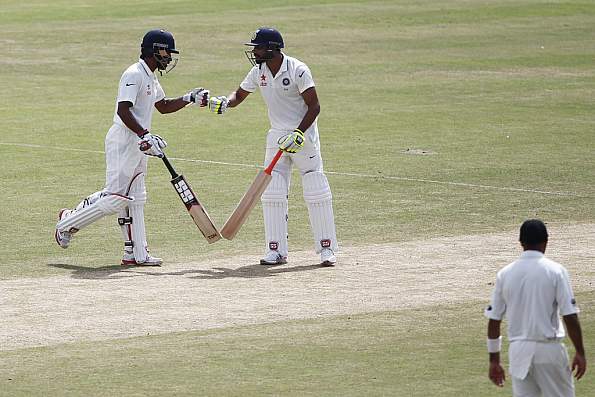Pat on the back for a tail that wags
There are few things more frustrating for an opposition team than a tail wagging, and wagging hard at that. It's quite the opposite of a dog. In Test matches, the runs scored by the tail matter less in terms of the amount scored when compared to the situation in which they are scored. India, under Virat Kohli, have enjoyed a lot of success in Tests recently and an unfancied reason for that is the tail.
Sample this: In India's last 13 Tests (including the one being played currently in Kolkata) two games were rain-affected draws. In the other 11 Tests, India's lower-order batsmen have scored telling runs.
Here's a brief summary of how things panned out:
In the first Test against Sri Lanka in Galle, India were 6 down for 302 before they stretched it to 375 with Saha scoring a 60.
In the second Test, India were 6 down for 319 but finished with 393. Saha 56, Amit Mishra 24.
In the third Test, India were 7 down for 180, but finished with 312. Mishra 59.
Against South Africa in Mohali, India were 7 down for 154. Finished with 201. Lead of 17. Jadeja 38, Ashwin 20.
In the third Test in Kanpur, India were 6 down for 125. Finished with 215. Saha 32, Jadeja 34, Ashwin 15.
In the fourth Test in Delhi, India were 7 down for 198. Finished with 334. Jadeja 24, Ashwin 56.
First Test against West Indies in Antigua. Saha 40, Mishra 53, Shami 17. 7,8, 9 adding 110 with an Ashwin ton at No 6.
Second Test, 5 down for 327. Finish with 500. Saha 47, Mishra 21.
Third Test, 5 down for 126. Ashwin and Saha tons. Finish with 353.
In Kanpur, against New Zealand, Ashwin at 7 scores 40. Jadeja at 8 scores 42. Finish with 318. First innings lead of 56.
In Kolkata, 231 for 7. Finish with 316. Ashwin 26, Saha 54, Jadeja 14, Shami 14.
Each of the above instance is from a first innings outing that India had, with each resulting in a lead. The most telling contributions of the lot cited above came in the low-scoring games. The other instances have seen them build on from a position of strength but in a lot of dicey situations, these runs have been imperative in swinging the game in India's favour.
It happened in Kanpur in the first Test when Jadeja added 41 with the last wicket. The same repeated today when he added 35 with the last wicket. Both times India were in danger of being bowled out for a total around 250 but ended up getting past the 300-run mark.
Now that mark, as Ronchi reckoned later in the press conference, isn't one that would have dented New Zealand psychologically. He cited that they would have taken this score before the start of the match. But it is the situation in which these runs have come that would have demoralised New Zealand. It is the second time they've let India off the hook in this series and with Bhuvneshwar Kumar's spell making every run a struggle, it is those extra runs conceded that they will look back on with grief when they do their analysis. They could have been staring at a deficit of 100 odd, instead of 188.
It is here that India have consistently gained an advantage in the past. Saha's fifty on Saturday (October 1) and his runs with Jadeja and Mohammad Shami were instrumental in getting New Zealand frustrated. The more they pressed hard for wickets, the more they were leaking runs. There's a reason why teams hate the tail. There can be little as frustrating in Test cricket as seeing it score runs. The bowlers run in thinking that their job is nearing an end but it gets stretched and stretched further to a point where they start losing focus on what is important.
Before the start of the Sri Lanka series, India didn't boast of a long tail. Saha was still finding his feet as a Test batsman. Now he has risen to a position of confidence and has gradually established himself as a dependable lower-order batsman. If Ashwin, the batsman, was less dependable then Saha would easily merit a spot higher in the line-up. But that Ashwin too has pushed himself higher up the pecking order is a reason why India's tail has become dependably longer.
The non-specialist batsmen, under Virat Kohli, average more than half of what the specialists do per innings. When India themselves look back at what has been going right, this is one aspect that stands out for sheer consistency. And something that deserves a pat on the back.













No comments: